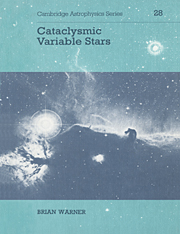1 - Historical Development
Published online by Cambridge University Press: 23 December 2009
Summary
History shows you prospects by starlight.
Rufus Choate. New England History.This first chapter is designed to give the reader an historical perspective on the subject of cataclysmic variable (CV) stars. Ground-based photometric and spectroscopic observational developments up to 1975 are treated in detail. Since that date instrumental methods in the optical region have been to some extent fixed, and to continue the historical approach would be repetitive of much of what appears in later chapters. The introduction of observational techniques in other wavelength regions is, however, followed beyond 1975
Pre-1900 Observations of Novae
If the ancient philosophers had been correct in their assertion that the distant stars are immutable, incorruptible and eternal, astronomy would be the dullest of disciplines. Fortunately, they were wrong on all counts. The stars possess variability on all time scales and amplitudes, sufficient to satisfy all interests, from the exotic to the commonplace, from the plodding to the impatient.
Among these, the most prominent celestial discordants are the novae Stella: new stars, challenging the ancients in their own times, but, such was the power of Aristotelian philosophy, passing almost entirely unacknowledged in European and Middle Eastern societies until the post-Copernican era (Clark & Stephenson 1977). In China, however, records of celestial events (kept mostly for astrological purposes) have been maintained since c. 1500 BC, and there are supporting and supplementary records in Japan from the seventh century AD and in Korea from c. 1000 AD (Clark & Stephenson 1976, 1977). Among these are numerous accounts of temporary objects, from which may be sifted comets, meteors, novae and supernovae.
- Type
- Chapter
- Information
- Cataclysmic Variable Stars , pp. 1 - 26Publisher: Cambridge University PressPrint publication year: 1995

